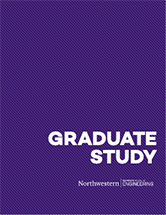Using Robotics to Explore Touch
Northwestern Medicine's Netta Gurari explains how she uses robotics to help people and how she's benefited from Northwestern's Master of Science in Robotics (MSR) program.
Netta Gurari is intrigued by the power of touch.
 As a Research Assistant Professor of Physical Therapy and Human Movement Sciences in Northwestern's Feinberg School of Medicine, Gurari applies her robotics background to the field of quantitative systems neuroscience to better understand the human sensorimotor system. Her hope is that understanding can help her develop more effective treatments for people whose motor control or haptic perception — the ability to grab something — are compromised.
As a Research Assistant Professor of Physical Therapy and Human Movement Sciences in Northwestern's Feinberg School of Medicine, Gurari applies her robotics background to the field of quantitative systems neuroscience to better understand the human sensorimotor system. Her hope is that understanding can help her develop more effective treatments for people whose motor control or haptic perception — the ability to grab something — are compromised.
Gurari has had the opportunity to work with multiple students and alumni from Northwestern's Master of Science in Robotics (MSR) program. She recently took the time to talk about the program and how her work has benefited from their expertise.
How do you use robotics to help people?
Many people face challenges in effectively controlling their movements to perform daily activities for numerous reasons. My goal is to use tools from the field of robotics to assess the reason that movement impairments occur in various populations and then to treat these movement impairments. By using robotics tools, I can create assessments and training protocols that are repeatable and that permit an individual’s performance to be quantified to a degree that is not currently possible with clinically available approaches.
What are you currently working on?
The focus of my current work is on force perception in individuals with stroke. Prior studies suggest that 5.6 million individuals with stroke living in the US are unable to accurately judge the relative forces that they generate with their two arms. This force perceptual impairment may have a substantial impact on the ability of these individuals to perform activities of daily living. The degree of impact of the force perceptual impairment, however, is currently unknown. My ongoing research is using a robotic system to examine the cause of force perceptual impairments, quantify its magnitude during unimanual and bimanual tasks, and test its neuroplasticity during bimanual training.
In what ways have you worked with MSR students or alumni?
I have worked with two individuals who were part of the MSR cohort. First, I have enjoyed conversations with Sabeen Admani, who was hired several years ago to work within our department. Sabeen has been a great person to bounce ideas off of and to assist with engineering and robotics needs. More recently, I have been working very closely with Ahalya Mandana as an advisor on her final robotics project. I have greatly enjoyed our one-on-one interactions as Ahalya has been helping to overhaul a robotic system and prepare a training protocol for individuals with stroke. Given how well our project went and the availability of funding, Ahalya will continue to work with me, as well as Sabeen.
What do you think are the benefits of the MSR program?
Benefits of the MSR program include gaining hands-on experience, receiving great mentoring advice from faculty members, engaging with students who come from a broad range of backgrounds, and developing a portfolio of interesting projects that demonstrate an impressive range of capabilities.

